#Kingdom of Han
Explore tagged Tumblr posts
Text





Kingdom Come Deliverance 2 (2024)
#gamingedit#kcdedit#kcd#kcd2#kingdom come deliverance#hans capon#henry of skalitz#usermaro#indiegamesource#dailygaming#kingdom come deliverance 2#kingdom come: deliverance#my edits
277 notes
·
View notes
Text


Good Evening to all 4 people in the KCD tags
#my art#kcd#kingdom come deliverance#kingdom come: deliverance#henry of skalitz#father godwin#hans capon#digital art#fanart#when KCD2 comes out. who knows. maybe there will be a whopping 7 people in the tags ;]#also please forgive me for using the most unreadable font ever. there is alt-text atleast#i love horrible blackletter fonts 😔
167 notes
·
View notes
Text

han, bang chan & changbin at kingdom legendary war
#stray kids#skz#han jisung#bang chan#changbin#3racha#kingdom legendary war#e:all in#p:twitter#210513
327 notes
·
View notes
Text
[餘智傳] The 2nd Century Warlord (Part 2)
based on the story by @romanceyourdemons
Read part 1

ninth day as a second century warlord i try to tactfully ask my fake liege lord if he sent the assassin to kill my loser liege lord and it turns out the idea of using assassins never occurred to him, but now that i’ve suggested it he’s really into it. in order to save my loser liege lord i volunteer to be the one to kill him
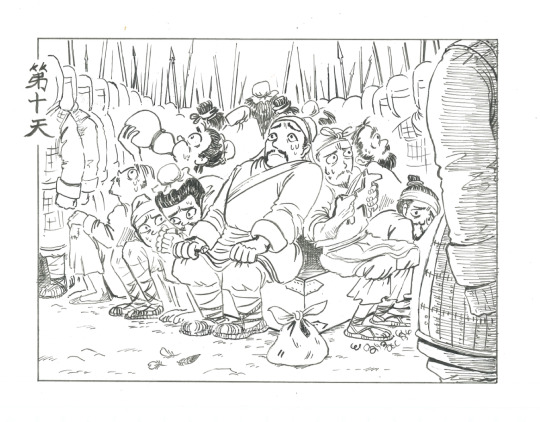
tenth day as a second century warlord on my way back to my loser liege lord’s city i realize i won’t be able to collect my men from my fake liege lord until i bring back my loser liege lord’s head. this would have been a great thing to think of before i got myself in this situation. i go back to my loser liege lord and ask him to rescue my men, and he tells me that if he could sack my fake liege lord’s camp he already would have. that doesn’t change the fact that my men are still trapped. they’re prisoners, even. i go back to my room to sulk
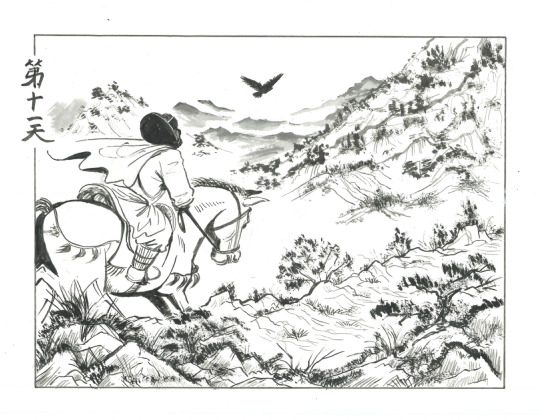
eleventh day as a second century warlord i find a little caged pigeon in the rafters of my loser liege lord’s room and deduce it belonged to the assassin. without asking permission or telling my loser liege lord goodbye i let the pigeon loose and follow it north. don’t ask what i was doing in my loser liege lord’s room. it’s not important
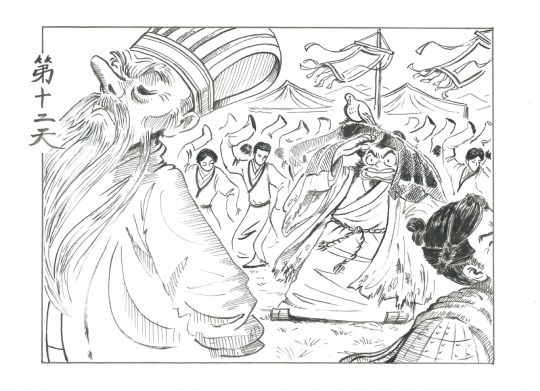
twelfth day as a second century warlord i disguise myself as a wizard and enter the camp of the coalition leader the pigeon led me to. in the middle of my little sleight of hand performance i make eye contact with the coalition leader’s second-in-command. IT’S THE WIZARD THAT STOLE MY LOSER LIEGE LORD’S WIFE. after the banquet i corner the fake wizard and ask him what the fuck is going on and he just says “wouldn’t you like to know” and leaves. i don’t know what to say to that so i just let him go

thirteenth day as a second century warlord i’m honestly so sick of not knowing what’s going on, so i adjust my wizard costume to passably disguise myself as a woman and break into the women’s area of the camp, where sure enough my loser liege lord’s wife is. i ask her what she’s doing here and she tells me the fake wizard overheard her singing a poem she overheard on the street, not knowing it contains the coalition leader’s formation’s weaknesses. the fake wizard kidnapped her and assigned an assassin to kill her husband before they figured out the poem’s significance. she shares the first couplet with me but i’m discovered and thrown out before she can share any more. she doesn’t need to. through a bizarre coincidence of homophones, it’s the poop version of my misinformation nursery rhyme
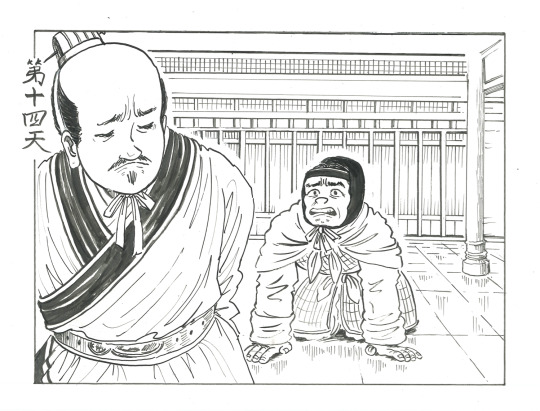
fourteenth day as a second century warlord i go back to my loser liege lord and tell him everything, urging him to join with my fake liege lord to attack the coalition leader according to the weaknesses in the nursery rhyme. he tells me frankly that he doesn’t trust me anymore. i ask him to execute me if that’s really true, because i can’t bear to live if i can’t protect him and i can’t protect my men. he agrees to attack the coalition leader

fifteenth day as a second century warlord. due to the information in the nursery rhyme, and thanks to my loser liege lord reminding me of the weather conditions multiple times while planning our battle strategy, our alliance carries the day. my loser liege lord gets his wife back. my men tell me that our fake liege lord actually treated them really well and they’d like to stay with him if i don’t mind. i do mind, now that neither the men i love nor the man i love have any use for me, but i don’t tell them that
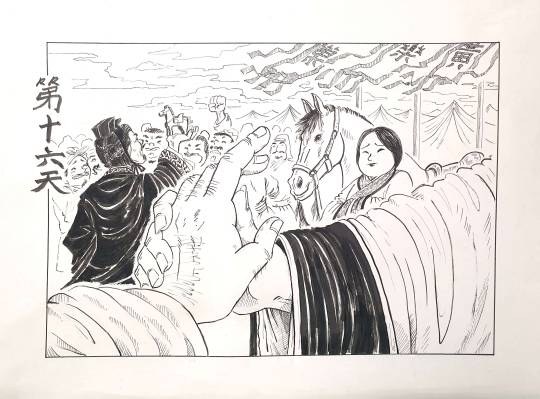
sixteenth day as a second century warlord i’m preparing to leave to i don’t know where, maybe to try to become a wizard for real, when my loser liege lord stops me and asks me where i’m going. he says he had hoped i would continue to work as his advisor. i was unaware i was his advisor in the first place. i agree, and he tells me he’s truly honored to have me in his service at last. he has known i am a rare and talented man with a strategic intelligence far above his ever since the day he witnessed me tying branches to my horses’ tails in six inches of mud, and could not for the life of him figure out why
The end.
Thanks for reading! Notes under the cut
CORRECTION#1: the warlord's courtesy name was incorrectly written as Yú zhī 餘知 [plentiful knowledge]. my dumbass did not realise zhī 知 [to know] is a GOD DAMN VERB. It should be zhì 智 [wisdom].
CORRECTION#2: the clothes from part one are from the WRONG DYNASTY!!! BY 1200 YEARS!!!! it's meant to be HAN not MING.
#9 Misreading the standards: Loser Liege's name is Yue, so I decided to go with Lè/Yuè 樂 [optimistic/music]. I made the Chad Liege's name Cháo 巢 [nest] which is pronounced identically to Cáo 曹, the infamous IRL warlord. Just like his IRL counterpart, he is the affable, lawful-evil boss who is kind to his employees. I went ALL OUT designing Lord Chad Chao's outfit. He's got so much drip the yangtze river is about to break its banks. Now THAT'S a main character!
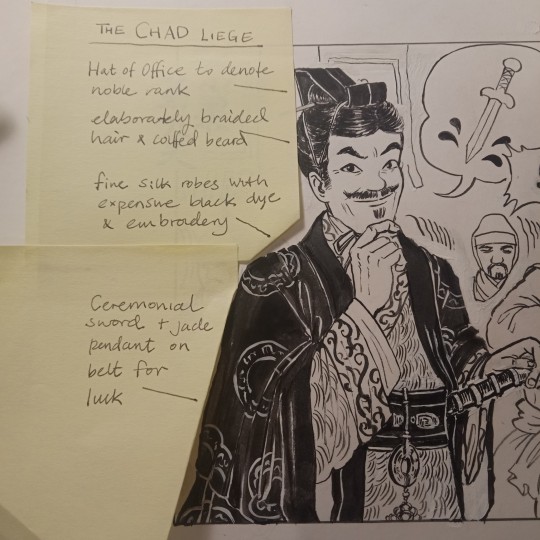
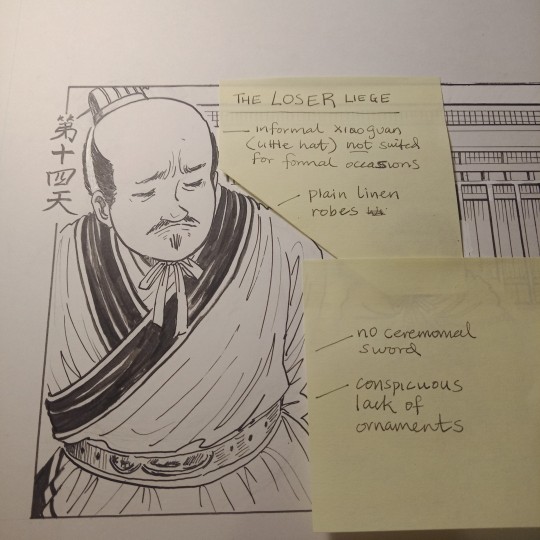
#10 Wardrobe Malfunction: the soldiers are now wearing clothes from the correct dynasty. i even gave them grass sandals! I really wanted to show how utterly outclassed they are, this is the difference between a peasant militia and a professional army. (They're in the exact same poses as part 1, except more terrified).
#11 mountain-water art: man i love doing traditional style backgrounds, the white space is very pleasing. Does it make sense to camp your coalition out in the mountains? No. Is it cool? Hella.
#12 you're a wizard, hairy: my favourite detail is the pigeon from day 11 sitting on the warlord's hat. I had to cut SO MUCH from this scene because there wasn't room. There was going to be musicians, jesters and strongmen. (Based of funerary figures)
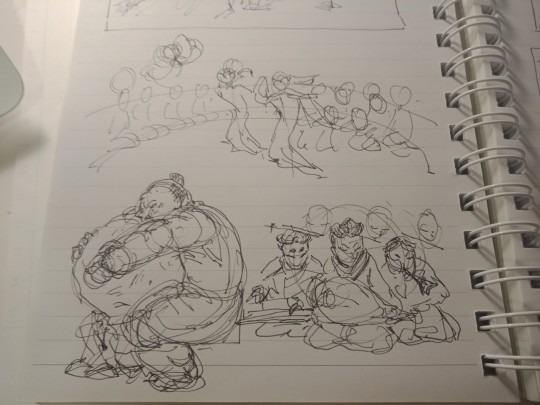


I wanted to make it clear that the Coalition Liege is the richest guy of all, but he is all style and no substance. He's got an army of dancing girls and drunk officers. You get the feeling that his Chief Strategist aka Fake Wizard aka Zhuge Liang Knockoff, disproves.
#13 Hua Mulan: RIP the Warlord's beautiful beard ;n; He's wearing one of the dancing girl's outfits and I like to think the ladies helped him do his makeup too. I wanted to add a little character moment for the Wife and Warlord. They're holding hands which is not strictly proper, but I wanted to show the intensity of the emotions.
#14 the supplicant: I really like the framing here, I wanted both faces to be visible so we can see what they're thinking.
#15 enemy of my enemy: the Warlord is finally in command and flying his standard Huáng 黃 [yellow]. He is wearing a wu guan with two pheasant feathers, for a high ranking military official.
#16 the romantic subplot: the Warlord and his Loser are tenderly holding hands while the Wife and Noble Steed looks on with approval. I wanted the handholding to be slightly awkward and kinda spontaneous, like they were both aiming for a manly, platonic hand-clasp but veered wildly off-course into homoeroticism. In the background, an oblivious Lord Chad is showing off the little wooden horse one of his new soldiers gave him (that guy's been carving it since part 1, it's high time we acknowledged his hard work).
Want to learn more about the (mostly) true story that inspired this post? Check out Romance of the Three Kingdoms! TV show, the book and the movie Red Cliff,
#second century warlord#han dynasty#romance of the three kingdoms#history#thanks for reading guys i had a blast drawing this
946 notes
·
View notes
Text
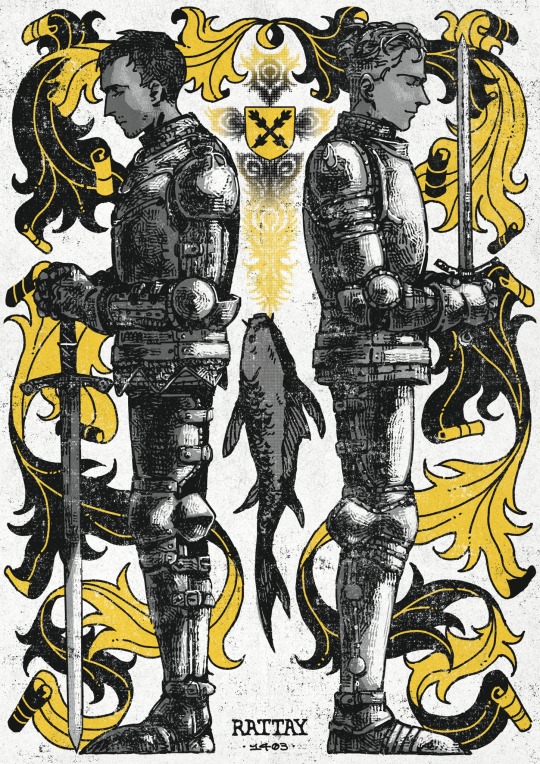
#mine#fanart#2024#kingdom come: deliverance#henry of skalitz#hans capon#favorite bit of this one is the carp#btw it’s inspired by lord of leipa coat of arms
192 notes
·
View notes
Text
April 13, Xi'an, China, Shaanxi Archaeology Museum/陕西考古博物馆 (Part 3 - Qin dynasty to Sui dynasty):
First up is one of many bronze edict tablets of the 2nd emperor of Qin dynasty, made in 209 BC. Inscribed upon it in Seal script is one of two edicts, specifically the one from the 2nd emperor of Qin dynasty (秦二世), which basically is a continuation of Qin Shi Huang's edict on standardizing all weights and measurements. Here Qin Shi Huang/秦始皇 is referred to as Shi Huangdi/始皇帝, where shi/始 means "origin", and huangdi/皇帝 means "emperor".

^The edict inscribed is as follows (this is my VERY rough translation, please take this with a grain of salt, I'm not great at reading Old Chinese; original text is on bottom right of picture):
“First year (209 BC; first year of 2nd Emperor of Qin's reign), [We] issued an edict to chancellors Li Si and Feng Quji: Shi Huangdi pioneered this effort to standardize all weights and measurements, since then all such edicts have been inscribed on bronze. Now that [We have] inherited this Huangdi title, [We] shall not refer to Ourselves as Shi Huangdi here. Likewise, should Our descendants continue to produce tablets of Shi Huangdi's edict, they shall not take credit for Shi Huangdi's achievements. [We] hereby inscribe this edict on the left, so that all may be clear."
Ever since Qin Shi Huang tried to standardize systems of measurements for the entire country, every dynasty since Qin dynasty has also done the same. These are the standardized weights and volume measurements (all made with bronze) from Western Han dynasty (202 - 8 BC). Those volume measurement tools are very much like oversized measurement spoons, since they are mostly used to measure liquids and grains (in ancient China grains can be measured by volume).

Looks like I forgot about this one in part 2, this is a bronze sword from Warring States period (475 - 221 BC), I believe. It's decorated with carved pieces of jade (some are on the scabbard, but the scabbard has presumably decomposed over time):

The painted and carved stone doorway to a Eastern Han dynasty (25 - 220 AD) tomb. The actual (double) doors are in the middle, and the pieces around them are the side jambs and the lintel. Note the animals, mythical creatures, and humans depicted. On the double doors, in order from top to bottom, there's a pair of Zhuque/朱雀/Vermilion Bird, a pair of symbolic door knockers shaped like a beast carrying a ring in its mouth, and a pair of oxen. On the top right and top left of the lintel piece, you can also clearly see the sun crow and the moon toad, respectively.

The layout of some Western Han dynasty (202 - 8 BC) mausoleums. Note that the "pyramids" on the model aren't stone pyramids like the Great Pyramid of Giza, they are actually fengtu/封土, or artificial mounds of earth on top of the actual tomb to symbolically seal the tomb (feng/封 means "seal" or "to seal"), and can serve as tomb markers. Fengtu can differ vastly in size according to the social status of the deceased, so the fengtu of imperial tombs are usually huge, some so big that they are like small hills. However, while Western Han dynasty imperial tombs have these square-ish fengtu mounds, in Eastern Han dynasty (25 - 220 AD) the fengtu mounds became circular, and imperial tomb fengtu have been circular pretty much ever since. But fengtu wasn't just reserved for the elites, common folk also built small circular fengtu mounds on top of graves (these graves are called fen/坟; graves without fengtu are called mu/墓), and this is still practiced today, albeit much more common in rural areas since there are less people and more land. When people tend to the graves of their family members and ancestors on Qingming Festival, if the grave is a fen grave, people would pile more earth on the fengtu to make it rounder as part of the upkeep process.

A set of pottery figurines of entertainers from a Western Han era tomb. I love how they set the display up here, you can practically imagine the music and the dancing

More pottery figurines from Western Han era tombs

Western Han era hollow clay bricks depicting the Four Symbols/四象 of the cardinal directions: Qinglong/青龙/Azure Dragon of the East, Zhuque/朱雀/Vermilion Bird of the South, Xuanwu/玄武/Black Tortoise of the North, and Baihu/白虎/White Tiger of the West.

Left: a piece of intricately painted lacquered wood, I forgot where it's from but it was probably a piece of decoration on a larger artifact. Right: a piece of gold decoration inlaid with turquoise from Western Han era


The biggest decorated yubi/玉璧 (jade disc with hole in the middle) found so far, from an early Western Han dynasty tomb. Its diameter is 43.2 cm (~17 inches). If you zoom in, the inner band is decorated with these almost tadpole-like little swirls, and these are called gu pattern/谷纹, since they might represent sprouting rice kernels. The outer band is decorated with 4 sets of kuilong patterns/夔龙纹 and 4 sets of dragon-phoenix patterns/龙凤纹. It's speculated that the patterns here together depict the universe, and the hole in the middle is where the spirit of the deceased will travel through. This particular yubi also has 六百六十一 ("six hundred and sixty-one") carved discreetly on the side, presumably a "serial number" left by the artisan who crafted this piece.

Decorated backs of bronze mirrors. I didn't take a picture of the plaque so I'm unclear on what time period these are from (may or may not be from the time period indicated at the beginning of the post):

Left: a hand-held incense burner. Right: a particular type of incense burner called a boshanlu/博山炉, so named because the lid was made to look like a mini mountain


Various Northern Zhou dynasty (557 - 581 AD) painted pottery figurines. Below middle arranged in a circle is the metal pieces on a belt.

Sixteen Kingoms era pottery entertainer figurines:

#2024 china#xi'an#china#shaanxi archaeology museum#chinese history#chinese culture#qin dynasty#han dynasty#northern zhou dynasty#sixteen kingdoms period#archaeology#history#culture
147 notes
·
View notes
Text

I was really surprised by the positive responses to my Hans' cosplay, so before the more serious photos are finished... Enjoy!

Photos by: Jana Braunová
#Theresa realising the wenches in the bathhouse are not the problem she should be worried about#kcd#kingdom come deliverance#hans capon#henry of skalitz#theresa#Hans capon cosplay#Henry of Skalitz cosplay#Cosplay
58 notes
·
View notes
Text
Varian and Hugo
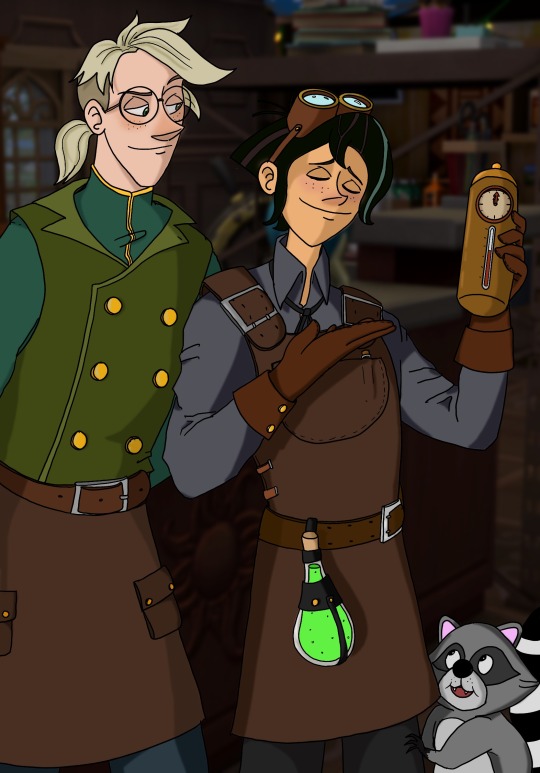
Ha, you didn’t see them coming, aye?
Varian and Hugo! What are they doing here?
Well. When Varian was going through his villain era, he made himself some debts to a lot of not-really-nice people, including a few pirates. After his adventures with his own bunch of friends in “Varian and the Seven Kingdoms” (of which we were robbed) he was finally forced to pay it back. So – he needed money. So – he started to sell innovative (though often explosive) stuff to people who like innovative (though often explosive) stuff. Even on lower prices, if a buyer will come back with a review and notes.
As for now, Varian’s debts are long paid, but well, the Republic of Pirates kinds grew on him. He now has his own store and lab, run mostly by Hugo (as Varian resides mostly in Corona), where they research, develop, test and sell his potions and inventions – as a found family. The young alchemist is highly respected here, he met a few other inventors, engineers and magic specialists (although he still DOES NOT WORK WITH MAGIC) and is collaborating with them – all to push history on the way of great progress! But even with the best intention in hand, he would still prefer Rapunzel and Eugene to not know about his side hustle…
Did you notice those little tubes Hans wears on his vest and uses as diversion during battles/boardings/when someone is chasing him? Where do you think he buys it? He even has a special discount – “from one reformed villain to another”. He also helps testing new trinkets out - and Varian is always impressed by his detailed feedback.
Special thanks for The Sims 4 for making me an amazing background!
#tangled#tangled the series#tangled varian#varian#varian and the 7 kingdoms#varian and the seven kingdoms#tts varian#varian and hugo#hugo vat7k#vat7k#frozen#fanfic#ruddiger#rapunzel#rapunzles tangled adventure#eugene fitzherbert#flynn rider#prince hans of the southern isles#hans frozen#hans disney#hans westergaard#hans of the southern isles#prince hans#fanfiction#republic of pirates#ruddiger the raccoon#kingdom of corona
58 notes
·
View notes
Text


just a day like another in Rattay
#mine#2024#fanart#kingdom come: deliverance#henry of skalitz#hans capon#it’s originally in mandarin and idk if the translation is spot on also that’s why some bubbles(?) seemed too small for its content#:/ srry abt that#also excuse my poor handwriting
117 notes
·
View notes
Text
April 14, Xi'an, China, Shaanxi History Museum, Qin and Han Dynasties Branch (Part 1 - Political Structure, Laws, and Military):
This was the final museum I went to while in Xi'an, and despite its name, it is not the Shaanxi History Museum/陕西历史博物馆. It is a new branch that's in a separate location from the main museum, so it's also referred to as the "Qin/Han Branch"/秦汉馆 (ugh I wish I could've gone to the main branch), and the museum building and its gates were supposed to imitate the look of Qin/Han-era palaces. It was raining cats and dogs the night before, so the ground still bear traces of that. I had fun though.

This museum doesn't have a lot of unique artifacts that other museums don't have, but instead focuses on the political structure, thought, life, and technologies from Qin and Han dynasties, so there were a lot of tables, maps, and diagrams in the museum. I will only be giving a brief summary of each thing here so these posts won't get too long (and take too much effort to make). If you understand Chinese though, these may be helpful worldbuilding references.
First is a rough timeline of the history Qin dynasty (221 - 207 BC) to Han dynasty (202 BC - 220 AD) (right side of timeline) and how it fits within the overall ancient world history (left side of timeline) in the same time frame, just as a general reference so museum visitors can have an idea of when these dynasties and events took place. The timeline included events starting from when Qin was still a state (Warring States period, 476 - 221 BC) until after the end of Han dynasty (Three Kingdoms period, 220 - 280 AD; and Western Jin dynasty, 265 - 317 AD). Here, 公元元年 means 1 CE/AD, so 公元前 means BCE/BC, and 公元 means CE/AD. Also I know the left side is hard to read, sorry about that, it was easier to read in person. There is a key at the bottom though:
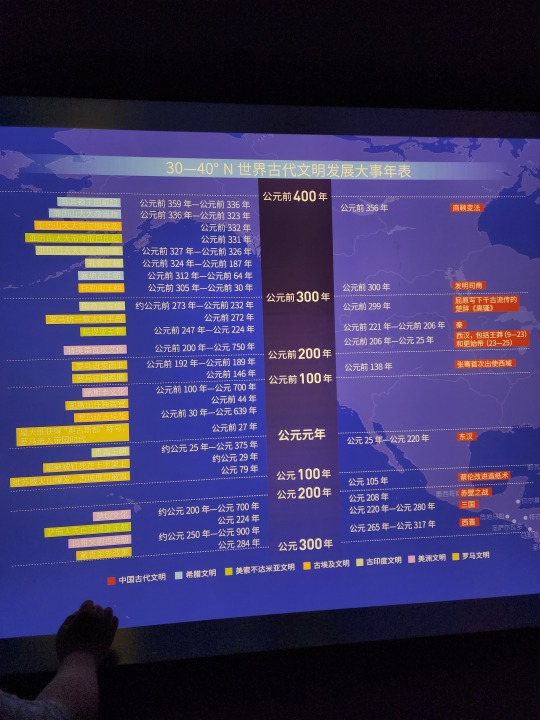
A diagram of the Three Lords and Nine Ministers system (三公九卿制) that was used as the central political structure of ancient China during Qin and Han dynasties, which was replaced by the Three Departments and Six Ministries system (三省六部制) in Sui dynasty (581 - 618 AD). There are many translations for the same positions, here I used what I think fits best for each position.
The Three Lords/三公 are (left to right on chart) : the Imperial Secretary/御史大夫 (handles the audit system and helps the chancellor), the Chancellor/丞相 (helps emperor handle national political affairs), and the Grand Commandant/太尉 (helps emperor handle military affairs).
The Nine Ministers/九卿 are (left to right): the Minister of Finance/治粟内史 (oversees public finance and tax system), the Minister of the Imperial Clan/宗正 (handles affairs within imperial clan), the Grand Herald/典客 (handles foreign policy), the Minister of the Guards/卫尉 (controls imperial guards), the Minister of Justice/廷尉 (oversees judicial system), the Minister of Attendants/郎中令 (controls palace guards, oversees imperial household, serves as imperial advisor, etc.), the Minister Coachman/太仆 (oversees the care, training, use, and purchase of horses; horses were an important resource in ancient times), the Lesser Treasurer/少府 (oversees the emperor's personal finances and some taxes), and the Minister of Ceremonies/奉常 (handles official ceremonies, worship, and rituals, oversees court astrologers and court scribes/historians).
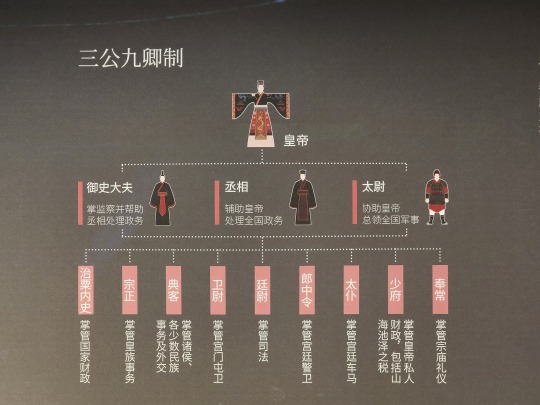
Qin and Han dynasty bureacratic systems. Right is Qin dynasty's system of commanderies/郡, counties/县, townships/乡, and villages/里 (levels of local government from highest to lowest). Left is Han dynasty's central government system, which designated the Three Lords and Nine Ministers system as the Outer Court/外朝 (executes policies), and added a Central Court/中朝 (decides policies).
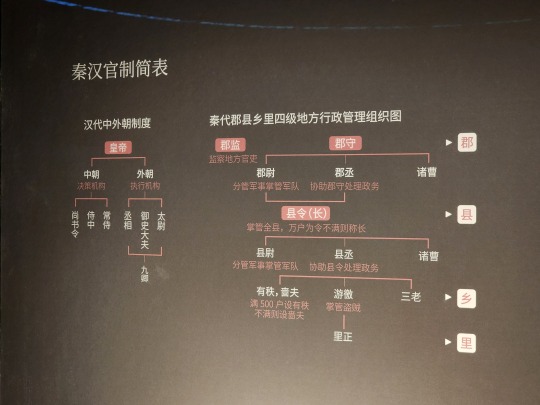
A list of the 48 commanderies during Qin dynasty and their locations today, grouped by where they were located before Qin dynasty (for example 7 of these groups were states during the Warring States period). A few of the names of these commanderies continue to be place names today, and some others often make appearances in modern novels.

The Recommendatory System/察举制 of Han dynasty, which was how officials were selected. Basically this process consists of a few steps: first the emperor would set what categories of talents are needed, then local government would recommend people to the central government accordingly. The emperor would ask the recommendees how they would deal with current issues, and then gave them positions based on how good their policy ideas were. Ideally the local officials would be impartial with recommendations, but in reality the local officials often belonged to powerful local clans, so these recommendations gradually became a way for the powerful clans to stay in power. This system was replaced by the Imperial Examination System/科举制 in later dynasties, which put more emphasis on exams as a way to select talents.


The locations of Qin and Han dynasty national temples, sacred mountains, and sacred bodies of water on a modern map. Of these, the temples marked in yellow were the temples dedicated to eight deities worshipped by the state of Qi, so they are collectively called the Eight Deities of Qi/齐地八神. Although the state of Qin eventually defeated the state of Qi, worship of these deities continued through Qin dynasty into Han dynasty. The temples marked in red were dedicated to deities worshipped by the state of Qin. The temples marked in purple were temples built in Han dynasty. The sacred waters are marked with wavy lines. The sacred mountains are marked in light blue-gray (a few are outside of this picture). MDZS fans may recognize Qishan/岐山 on this map, and Three Kingdoms enthusiasts may recognize jieshishan/碣石山 as the place Cao Cao visited when he wrote the line "东临碣石,以观沧海" in his famous poem.
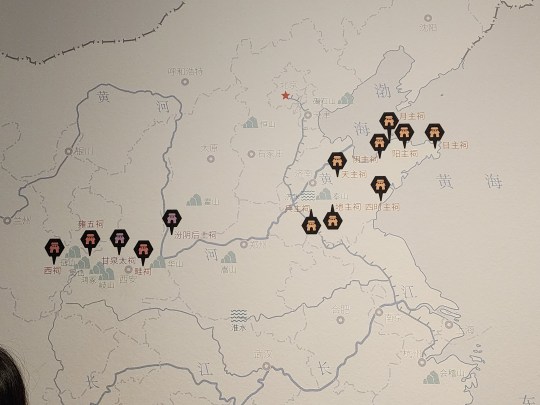
Replicas of a small part of the Qin-era bamboo texts found in a tomb of a Qin dynasty official at Shuihudi (睡虎地秦简). The originals are at Hubei Provincial Museum/湖北省博物馆. Many of these texts concern laws and decrees of Qin dynasty, and in another tomb in the same area there were also the oldest letters ever found in China (link goes to the full digitized text). These bamboo slips are meant to read from top to bottom, right to left, and the construction of bamboo scrolls are actually the very reason why Chinese texts read this way traditionally even on printed texts during later dynasties.
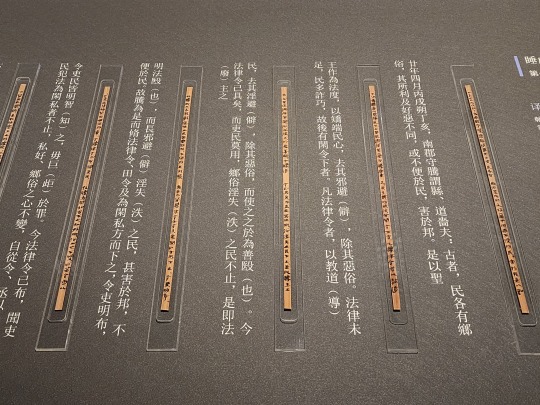
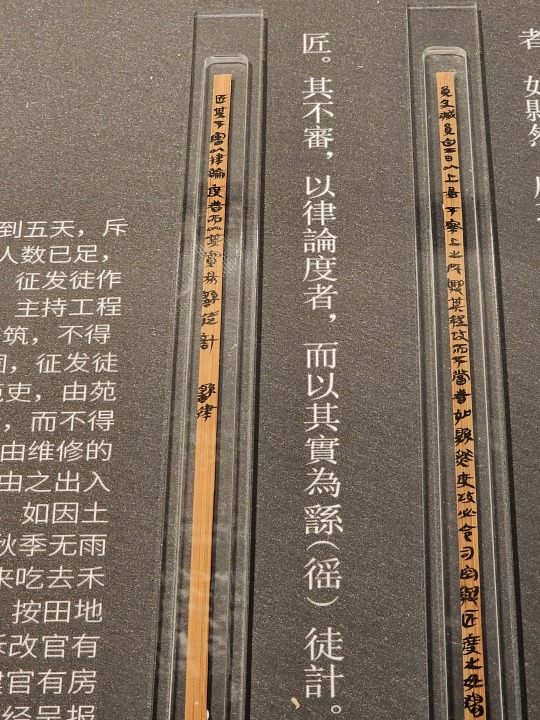
This was something I'd written about in the MDZS posts a few years ago, and now I've finally seen the real thing with my own eyes: the Tiger Tally/虎符 (I translated it as "Tiger Amulet" in that post but in fact "Tally" is the correct translation). Tiger tallys have two halves, each with gilded gold text upon them. This particular artifact is the left half of a tiger tally from late Warring States period (state of Qin), and reads:
"This is a tally of the armed forces, right half goes to the ruler of Qin, left half goes to (the official of) Du county. When the need to dispatch armored troops of over 50 soldiers arises, this half must find the other half held by the ruler in order to authorize this military activity. In case of emergency, there is no need to wait for this authorization." (“兵甲之符,右才君,左才杜。凡兴士披甲用兵五十人以上,必会君符,乃敢行之。燔燧之事,虽毋会符,行殹。”)
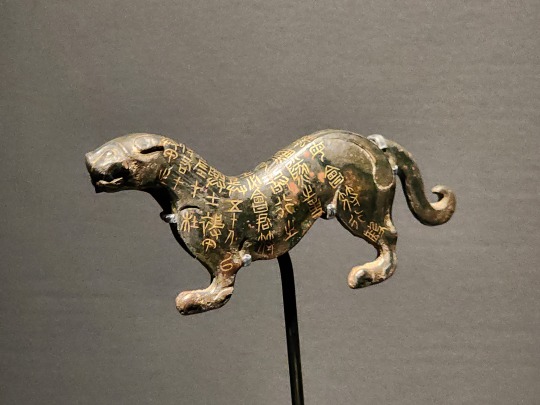
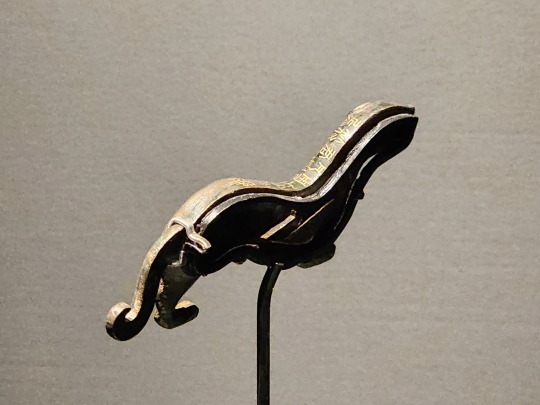
The different currencies (coins) of the states of Warring States period:
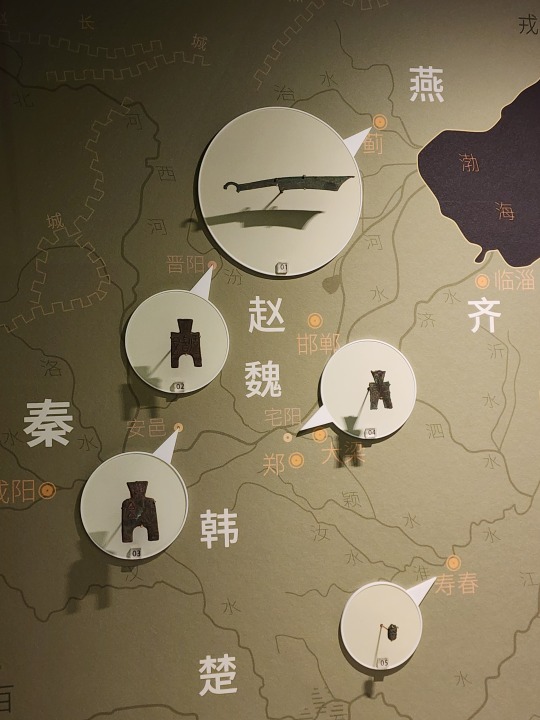
The different coins and coin molds during Qin and Han dynasties:
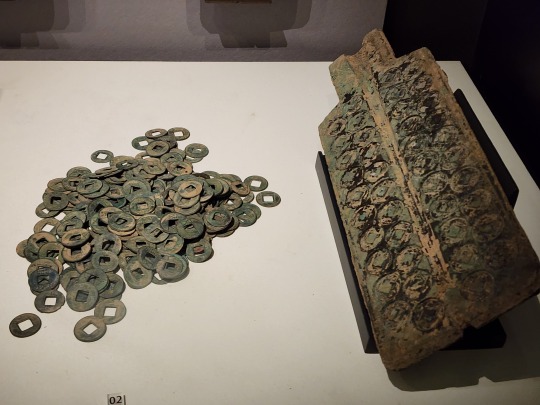
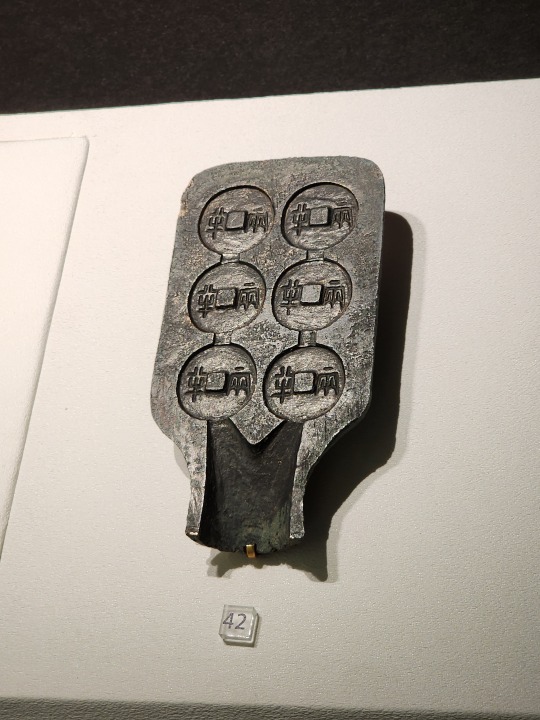
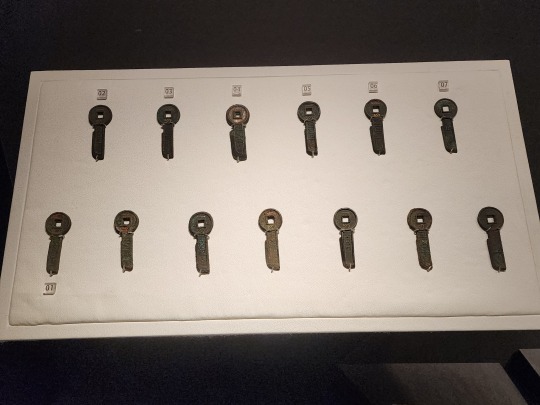
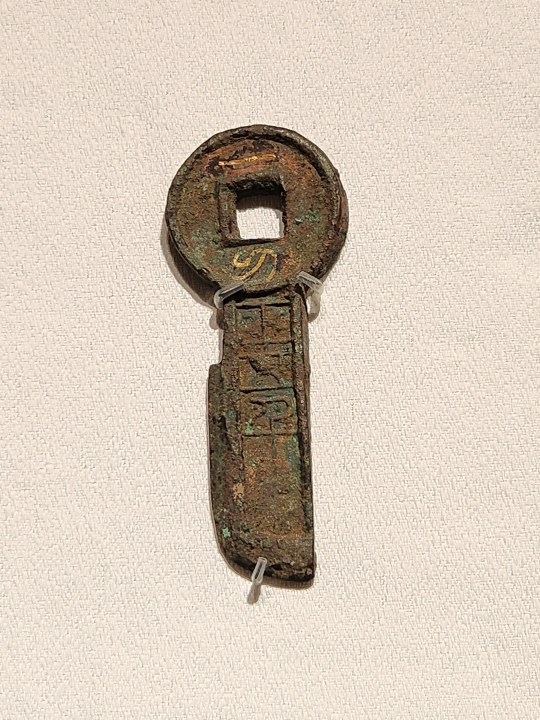
Left: Han dynasty disk-shaped gold ingots; these were rare currencies at the time and were mainly exchanged between the imperial family and nobility as gifts. Right: a standard weight from Qin dynasty that reads "weighs 30 jin/斤". Since Qin dynasty unified systems of measurements, and this weight is known to weigh 7.5 kg, we can easily convert the Qin-era jin to the modern kg (1 Qin-era jin = 0.25 kg).
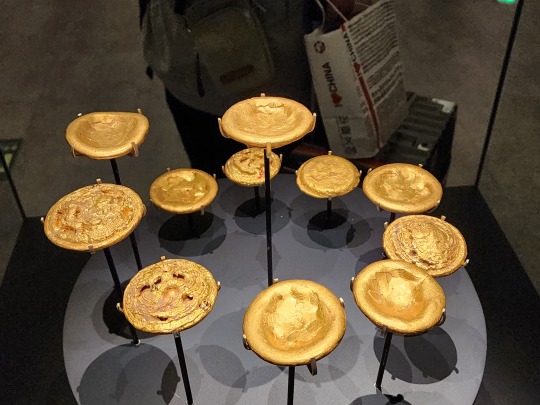
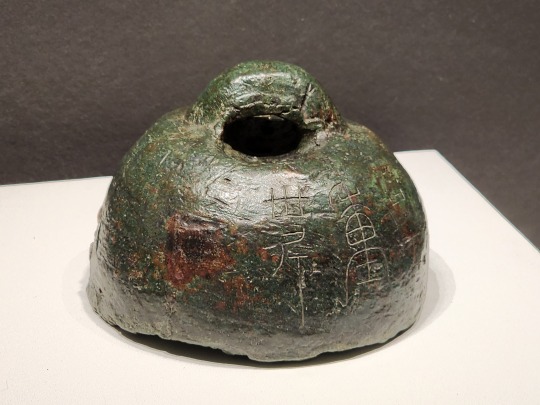
Terra cotta soldier and horse from Qin Shihuang's mausoleum. As some people have pointed out, these terra cotta soldiers were fully painted and colorful when they were first excavated, but when exposed to air, the paint quickly peeled and the colors faded, leaving the sculptures in their familiar clay-color. Few of these sculptures still have their original colors intact, thanks to preservation efforts. The immense difficulty of preservation is also a reason why modern Chinese archaeology has that rule of "don't excavate unless absolutely necessary".
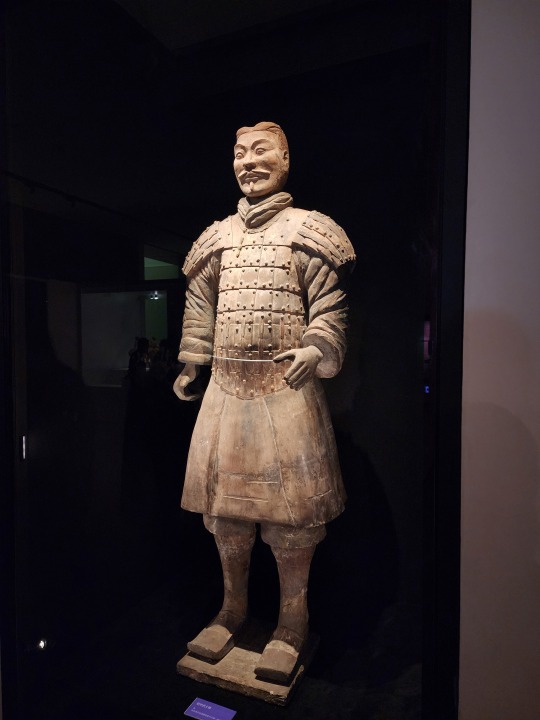
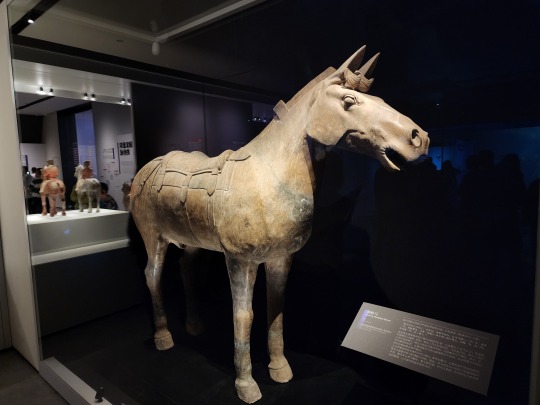
A Qin-era bronze jian/剑 (double-edged straight sword) from Qin Shihuang's mausoleum:

Left: Qin-era bronze spear heads and a pi/铍 head (on the right; pi is a type of ancient Chinese polearm). Right: Han-era ring-pommel dao/环首刀 (dao is a single-edged sword that can be straight or curved; interestingly, many ring-pommel dao artifacts exhibit a forward curve). Ring-pommel dao continued to be used in the military after Han dynasty.
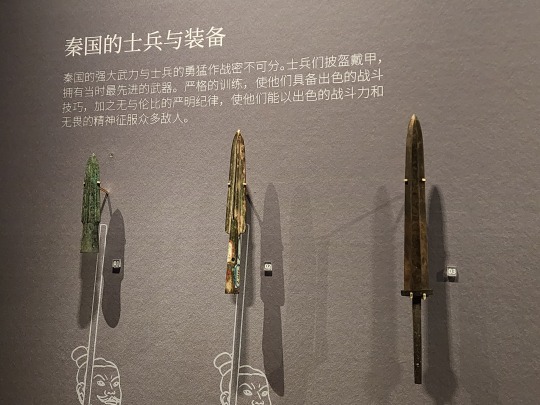
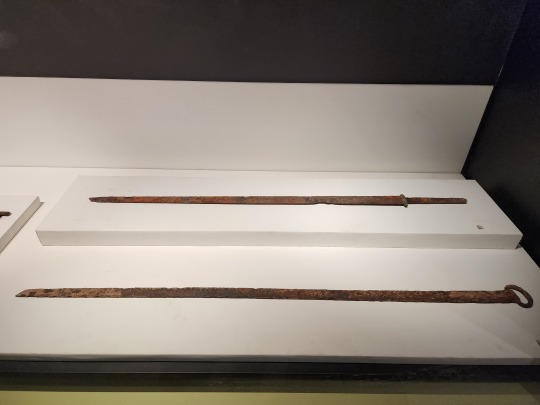
A suit of armor made out of stone from Qin Shihuang's mausoleum. These armor sets weigh about 18 kg or 39.7 lbs each, which is........actually not too bad. There are specialized armor sets in later dynasties that can weigh 30 kg or 66 lbs.
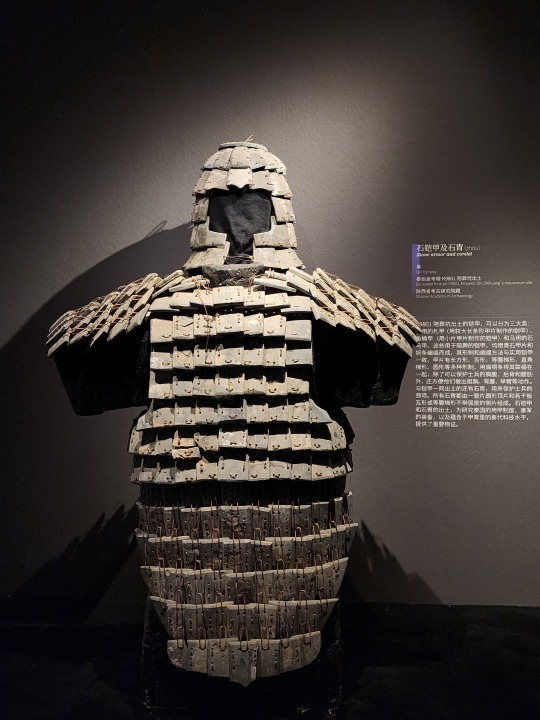
#2024 china#xi'an#china#shaanxi history museum qin and han dynasties branch#chinese history#qin dynasty#han dynasty#warring states period#three kingdoms#history#archaeology#mdzs
72 notes
·
View notes
Text
I will never shut up about how Kingdom Come: Deliverance is the most tenderly written game served to the most loutish horde of jackasses. I think it is possibly one of the greatest pieces of popular fiction made about feudalism in recent history, even if it's not always the most historically accurate.
And that's because the whole damn thing is about the profound, authority-enforced inhumanity that self-propels feudal order... but this time, it's written from the perspective of, for lack of better word, "humanity undermines, and humanity wins."
Love wins, if you want to be cheeky.
This was originally meant to be a reply to @feelinungry's excellent post on the subject, but it outgrew itself and got super bloated, so I'm plopping it in its own post to not be obnoxious...
KINGDOM COME: DELIVERANCE MAJOR SPOILERS BELOW
And the reason all this about humanity and love is so important to the core of the story, to the very backbone of the narrative (even beyond the plot), is that it exists in opposition and to the impairment of the feudal system. Kingdom Come: Deliverance means to teach us, by way of deeply dramatic plots following individuals, how feudalism works and why it worked the way it did. And why and how that system fails.
The vehicle by which the game does this is by showing us, over and over, how the stratification of feudal class is eroded and sometimes outright dissolved (either in general, as with Henry and Hans, or when it matters most, as with Radzig and Henry) by plain and simple love.
Feudalism, like most class-stratified systems, relies upon 1. dehumanization of those beneath one's appointed status; 2. fealty (mock-love) to those above one's status, their title-appointer class; and 3. the maintenance of a deep separation between these artificially bestowed statuses, as enforced by church (as in word of clergy, not word of god) & state (legal rules and law). Those words and laws existed to propel the system by divide-and-maintain (of the workforce populace, placing it firmly below the next class in line, etc.) in the service of unify-and-profit (for the ruling class).
Sigismund & his invading army are wholly separated and adherent to the feudal theory, even if they have flouted codes of warfare & inheritance; they are presented to us as the main dehumanizing force of the story world, a wave of Order that indiscriminately burns opposition flat rather than an individual leading a royal coup, a cyclical destruction that paves the way for the next flavor of rule to continue the feudal system ad infinitum. They're thoroughly separated from the story even when they are burning down a village in front of our eyes and generally move as one, with Markvart occasionally stepping out of that mass of Feudalism and its antihuman nature to give it a face. They're more a force of nature than an individual as far as the narrative goes.
And we are meant to understand that in sharp contrast to the "close" story, the cast we get to know and watch as they attempt to answer this force of nature. And the second we see these characters get close enough to each other, by raw proximity, to poke a pin into the wineskin of feudal order as dictated to them by authority, it bleeds--everywhere. Not in the sense of ruination but in the sense that a tiny wedge of empathy cracks open the dam and leads, yep, to rehumanization--and love, the most human driving force there is.
And that changes everything, for everyone. Not just internally, as with a character's personal development arc (i.e., Hans learning why his duties, which he resented and viewed as an impingement on his freedom when dictated to him by authority, are incredibly important for real people who experience pain) but externally as well (as @feelinungry so elegantly points out in the original post).
Over and over, at every stage of the story, it's the rehumanization of and by these decision-makers (at a family level, at a community level, at a regional level, at a national level) that cracks the feudal cycle, even if in very small ways. Hans really brings this back home in a petri dish in late game, after the siege, when he complains to Henry about the noble's code (letting Istvan go) potentially leading to pain and disaster for the common people Istvan's machinations are likely to harm in the future. He chafes--and we chafe, and so does Radzig, and so does Divish--against feudal stratification because he has learned a general empathy through loving an individual, and that has in turn reshaped the way he sees the world.
And that's exactly why and when feudalism begins to fail, and why it thrashed itself the way it did, from the enforcement of sexual mores (though this wasn't exactly like it is in movies) and gender law to terror upon its own populations.
And it's the crucial understanding I think we begin to forget after being exposed to so much Hollywoodification of history, where the oppression always exists for cruelty's sake alone rather than in active and deliberate service to a political construct.
And I think it's why we've "lost the plot" so horribly when it comes to understanding that people in history were still people, not monolithic one-mind entities (as the feudal system demanded they be). And why we somehow forgot that such people fall in love, in all kinds of love, in a way that has never given a damn about authority. And that this in turn undermines supposedly supreme authority, even divine authority, and will always continue to do so, as long as people are people.
This is what it always comes back to. Always. From Henry's parents and their mysterious bond with Radzig informing the protagonist's journey from "the past"--to Henry & Hans falling into stupidly fierce soulmatehood with each other in the present--from Istvan & Erik's destructive fuck-the-world romantic love on the "enemy" side--to Divish's humbling, humanizing realization that he loves Stephanie in some way, he really does, despite the chasm of age/gender enforced upon them by their adherence to feudal order that doomed their romantic love to failure.
People will always love each other, even when the world orders them not to, even when faced with death and worse. People will always, given proximity and shared experiences, learn to see each other as human again. KCD reminds us of that. It's why the "slow" storyline exists and why it works.
And that is why this game is so fucking fantastic, and why the genpop fandom has utterly failed it.
#kingdom come deliverance#kcd#kcd2#henry of skalitz#hans capon#radzig kobyla#divish of talmberg#stephanie of talmberg#redmeta
147 notes
·
View notes
Text
Secret of Three Kingdoms (三国机密) | Cdrama | Whump List

Genre: Historical, Romance, Drama, Political, War
Synopsis: The last hope of the crumbling Han Dynasty bears an unspeakable secret with the power to destroy the imperial rule it seeks to save during the turbulent Three Kingdoms era, tied to a cold case related to the unsolved murder of a young man from the countryside.
Length: 54 eps
Whump meter: ▲◭△△△ Whumpy Things: Bro whump, sensitive whumpee
✨ Absolutely fascinating drama with great lead couple, omg. There was unfortunately not as much whump as I would have liked but there's a substantial bit of emotional whump and plenty angst✨
⚠️Trigger Content: Violence, mild gore, s**cide (explicitly shown and talked about frequently by a lead character), usual historical cdrama CWs (most triggering eps at the bottom) ⚠️⚠️Some SPOILERS will be found, proceed with caution⚠️⚠️

Whumpee: Liu Xie / Liu Ping portrayed by Ma Tian Yu
Ep 1 | Concern for loved one, teary eyed, labored breathing | stepped on, winces x2 | In shock.
Ep 2 | In shock, crying | Caught in a fire, saved, weak, comforted, concern for him.
Ep 3 | None.
Ep 4 | [04:35] Struggling to hold someone back, bitten in the arm, in pain, teary eyed, bite mark visible on his arm | [16:17] Wound turned red, arm wrapped up.
Ep 5 | Scolded, concern for loved one, yelled at | [36:20] Concern for loved one, scolded, grabbed by his clothes and pushed against the wall, scolded, yelled at, crying, begging to save loved one.
Ep 6-8 | Distressed, crying, scolded. He cries a lot. (ep 8 - Angry)
Ep 9 | [07:25] Mourning death of loved one, on his knees, crying, angry | [18:55] Guilty, has a breakdown, crying | Slapped.
Ep 10 | None.
Ep 11 | Teary eyed | Yelled at.
Ep 12-20 | None.
Ep 21 | Fought. Restrained, sword held to his neck. Imprisoned.
Ep 22-23 | None.
Ep 24 | Arrested, bound to cross, hit with an arrow a bunch (semi-comedic), dragged away.
Ep 25-27 | None.
Ep 28 | Imprisoned, chained | Weak due to being starved, pale, wrists injured from the chains, struggling to walk | Made to kneel.
Ep 29 | Brief injury reveal, concern for him.
Ep 30-31 | None.
Ep 32 | Slapped x2, emotional.
Ep 33-37 | None.
Ep 38-40 | Emotional, crying.
Ep 41 | Fought in a war | Scolded, slapped, emotional, crying.
Ep 42-44 | None.
Ep 45 | [23:50] Teary eyed | Made to watch his brother be tortured unable to do anything to save him, tearing up.
Ep 46 | Emotional, tearing up.
Ep 47 | None.
Ep 48 | Witnesses loved one die, crying | Emotional, crying x2 | Crying, grabs sword by the blade, bleeding, blood covered hand.
Ep 49-51 | Emotional, crying. Witnesses the death of a loved one (Ep 50).
Ep 52-54 | None.

Whumpee: Sima Yi (Zhong Da) portrayed by Elvis Han
Ep 1 | Told loved one died, teary eyed.
Ep 2-10 | Threatened with a sword held to his neck a couple of times (ep 3, 5, 8).
Ep 11 | [26:26] Throws himself in front of someone to protect them from an attack, stabbed in the shoulder, on the ground, yelps, helped sit up, clutching wound, winces.
Ep 12 | No appearance.
Ep 13 | Recovering from injury, being fed medicine, heavy breathing, pale, moves but is stopped by a sudden pain, clutches chest, coughing, struggles to get up and dressed, labored breathing, winces, groans.
Ep 14 | Sudden pain from previous wound.
Ep 15 | [13:28] Knife thrown at him and stabs him in the leg (off-screen), screams, concern for him, clutching leg, in pain, knife suddenly pulled out, cries out, bandaged up, winces, helped to stand, winces again, helped to walk, limping, winces, labored breathing | Wakes up, winces.
Ep 16 | Using a crutch to walk, struggles to kneel, struggles to get back up | Threatened with a sword.
Ep 17 | Wound touched, cries out in pain, groaning | Helped to walk, limping | Kicked on his wounded leg, crying out in pain, helped to walk. In pain.
Ep 18 | No appearance.
Ep 19-20 | None.
Ep 21 | Restrained, arrested. Bound to cross. Arrested again.
Ep 22 | Imprisoned.
Ep 23-27 | None.
Ep 28 | Fought, kicked to the ground and falls unconscious.
Ep 29-30 | None.
Ep 31 | Emotional, concerned for loved one.
Ep 32-33| None.
Ep 34 | Fought, knocked down, saved.
Ep 35 | Stabbed in the abdomen, falls to the ground, concern for him, passes out | In bed, concern for him, weak | In a wheelchair (pretending) | Recieving acupuncture as a form of torture disguised as treatment, in pain.
Ep 36-41 | None.
Ep 42 | Arrested. In prison.
Ep 43-44 | None.
Ep 45 | [23:50] Arrested | Tied to cross, interrogated, hot iron tool pressed onto his chest, groaning in agony, screaming, sweating, iron removed to reveal burn, threatened with another, saved, wound pressed, groaning.
Ep 46 | Imprisoned, curled up on the floor, pale, weak, wound visible on his chest.
Ep 47 | None.
Ep 48 | Told loved one died, crying, mourning.
Ep 49-50 | None.
Ep 51 | Stabbed in the shoulder with the tip of a sword, winces, sweating, clutching wound.
Ep 52 | Punched, bloody lip, coughing.
Ep 53-54 | None.

Whumpee: Cao Pi portrayed by Tan Jian Ci
Ep 1-4 | No appearance.
Ep 5-7 | None.
Ep 8 | Fought | Labored breathing, sweating, blood on his face.
Ep 9 | None.
Ep 10 | Crying, angry | Made to kneel to receive punishment, beaten repeatedly with a rod, scolded, concern for him, saved.
Ep 11 | [14:00] Held hostage with a sword to his throat, sword pressed to his neck, bleeding, kicked onto the ground, slashed in the neck, falls to the ground, concern for him, bleeding a lot, spasming, wound treated hastily, unconscious, neck bandaged | Carried away, still unconscious.
Ep 12 | [41:15] Lying in bed, struggling to sit up, raspy voice and struggling to talk, weak, pale, blood staining the bandage around his neck, grunts, struggles to lie back down.
Ep 13 | Asleep in bed, weak, barely moving, raspy voice, struggles to sit up.
Ep 14-15 | No appearance.
Ep 16 | Still bed-ridden, weak, pale.
Ep 17-18 | No appearance.
Scar visible on his neck from this point onwards.
Ep 19-20 | None.
Ep 21 | Fought, kicked in the chest, kneed in the head, falls onto the ground, unconscious | Imprisoned, still unconscious. Stirs awake, coughing, clutching head, struggling to get up, weak, groaning.
Ep 22 | Arrested (off-screen). Bound, swords held to his neck, made to kneel, grabbed by the collar, shoved, saved.
Ep 23 | None.
Ep 24 | Punched, clutching jaw, bloody lip, restrained, arrested. Bound to cross.
Ep 25 | Still bound, lip bruised.
Ep 26 | None.
Ep 27 | Swords held to his neck, restrained, arrested. | Slapped x3, stumbles | Bruise visible on his cheek, bound to cross, whipped in the chest x3, groaning, labored breathing, knife held to his neck, teary eyed. | Saved, collapses onto saviour, weak, helped to walk.
Ep 28 | Fought.
Ep 29 | None.
Ep 30 | Bound, kicked in the back of the knee and falls onto his knees. In shock, emotional |Fought, defeated, on the ground, bruise on his cheek, sword held to his neck.
Ep 31 | Unconscious on the ground, stirring awake, clutching head, groaning.
Ep 32 | Emotional, crying, slapped.
Ep 33-34 | None.
Ep 35 | In pain after kneeling for very long.
Ep 36 | Sword held to his neck.
Ep 37 | Made himself bleed from the finger.
Ep 38 | Emotional, accidentally(?) cuts his hand with his blade.
Ep 39-46 | None.
Ep 47 | Fought, special move™ performed against his chest knocking him back, kicked on the shoulder, falls onto the floor, unconscious, concern for him.
Ep 48 | Recovering in bed, unconscious, pale, emotional, crying.
Ep 49 | Digs until his hands bleed.
Ep 50 | None
Ep 51 | Stops blade with hand, bleeding. Hand bandaged.
Ep 52-53 | None.
Ep 54 | Hit with an object. Bleeding from the mouth. Teary eyed | Emotional, crying, bleeding from the mouth again, spits blood.
── ⋅ ⋅ ── ⋅ ⋅ ── ⋅ ⋅ ── ⋅ ⋅ ── ⋅ ⋅ ── ⋅ ⋅ ── ⋅ ⋅ ── ⋅ ⋅ ── ⋅ ⋅ ── ⋅ ⋅ ── ⋅ ⋅ ──
Eps to watch out for violence, gore & s**cide:
Ep 1: Slight gore. Ep 17: Mild gore, s*icide (pretty graphic). Ep 28: Mild gore [33:12 - 33:30] Ep 38: Bloody death (beginning)
#asian whump#whump list#whumplist#whump#cdrama#chinese drama#secret of three kingdoms#三国机密#ma tian yu#elvis han#tian jian ci#ma tianyu#tian jianci
54 notes
·
View notes
Text
Let The World Burn. - I.N.
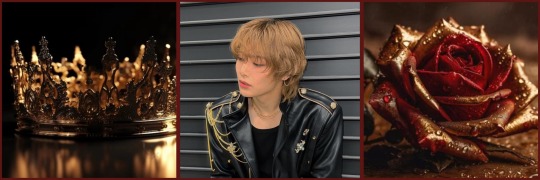
The nation of Rexerum was a country of power, respected and feared by all nations surrounding it.
The golden nation’s shine was dulled by the blood that had been spilled due to the King’s corrupt rule and ambition.
Yang Jeongin was to take the throne in the far future, but after his fathers unexpected passing, the burden of the crown was bestowed upon him a lot sooner than he anticipated.
He finds out the hard way that even a king lacks absolute control. His desires paled in the shadow of the responsibilities of the crown.
The only thing he has the rights to is his own heart.
In this cruel world his fate had been sealed before he was born. What he chooses to do with the power that had been bestowed upon him would determine the fate of the nation.
In the end, he managed to forget that a king is nothing without his queen.
~
Warnings: ANGST, implied smut, war, aggression, anxiety, depression, death, please let me know if i miss anything...
~
Chapters:
The New King and Queen
Cold Hearted
Frustrations
Drunk in Love
....
~
#stray kids#stray kids imagine#kpop imagine#stray kids x reader#bang Chan#lee know#changbin#seungmin#Hyunjin#Felix#Yongbok#Han Jisung#Jeongin#angst#fluff#fanfic#y/n#enemies to lovers#non idol au#mini series#skz#stray kids x reader angst#skz x reader fluff#skz x reader angst#royal au#royal!skz#prince jeongin#king jeongin#royalty#kingdom
100 notes
·
View notes
Text
Henry of Skalitz, Hans Capon cosplay photos
I didn't want to spam this account with KCD at first, but who cares. Until we finish our Rorveth costumes, it would be dead here anyway so... enjoy!
More photos bellow the cut. AND!
WE HAVE A DOG ON THESE!






We have a whole series, but since we had like 8 photographers with us and we are still waiting for the rest of them, I'll start with these epic photos by: Irena Karpíšková
Next part is going to be from Hans' camp and the boar hunting and we also have poor Hans in the Cuman camp!
---
Our Instagram accounts for more cosplays:
Hans
Henry
#kcd#kingdom come deliverance#hans capon#henry of skalitz#Hans capon cosplay#Henry of Skalitz cosplay#Cosplay
39 notes
·
View notes
Text


This is because of one kingdom performance 3 years ago by the way. Stop I’m so proud of them 🥹
#skz#stray kids#stay#hyunjin#lee felix#lee know#bang chan#changbin#han jisung#seungmin#jeongin#kingdom#ate album#comeback#chkchkboom
79 notes
·
View notes
Text
To summarize Alberu's Korean arc experience thru an Isekai title:
“In another world to save my crazy dongsaeng who got kidnapped by a god and wow this bastard is a transmigrator along with his swordmaster who's secretly a grandpa which I never really expected and oh I also became a tiger monster because of some god and I am now a part-time shampoo commercial model!”
(With how much the Korean arc emphasized the Dark Tiger's lustrous and majestic mane every time he shakes it, you'd think Alberu became a shampoo commercial model in another world 🤣)
#shampoo commercial model in another world#his highness alberu crossman#the shining sun of roan kingdom#you look so damn FINE whatever form you take#y'all this is a MONSTER and he managed to pull off the elegant aristocratic powerfully arrogant vibe inherent to big cats#okay i'll shut up now#lout of the count’s family#lcf#alberu crossman#cale henituse#choi han#tcf novel#tcf meme#sealed god's test#tcf humor
315 notes
·
View notes